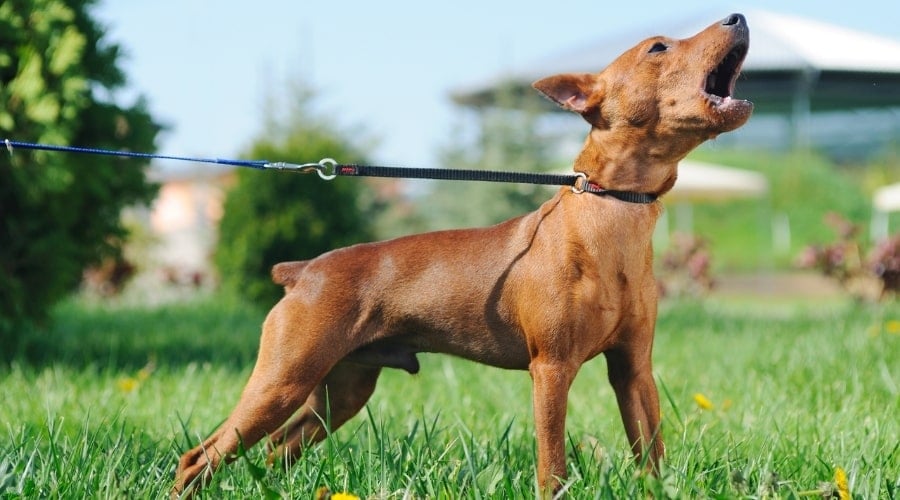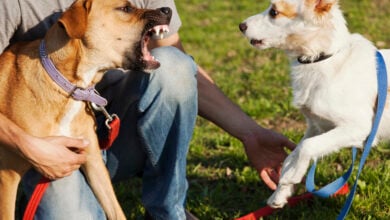Why Do Dogs Wag Their Tails? It’s Not Always A Sign Of Happiness!
When you purchase through links on our site, we may earn a commission. Here’s how it works.
We’ve all seen it: a dog’s tail wagging like a little furry windshield wiper, clearing the way for belly rubs and treats. It’s supposed to mean they’re happy, right? Well, maybe. Maybe not.
Table of Contents
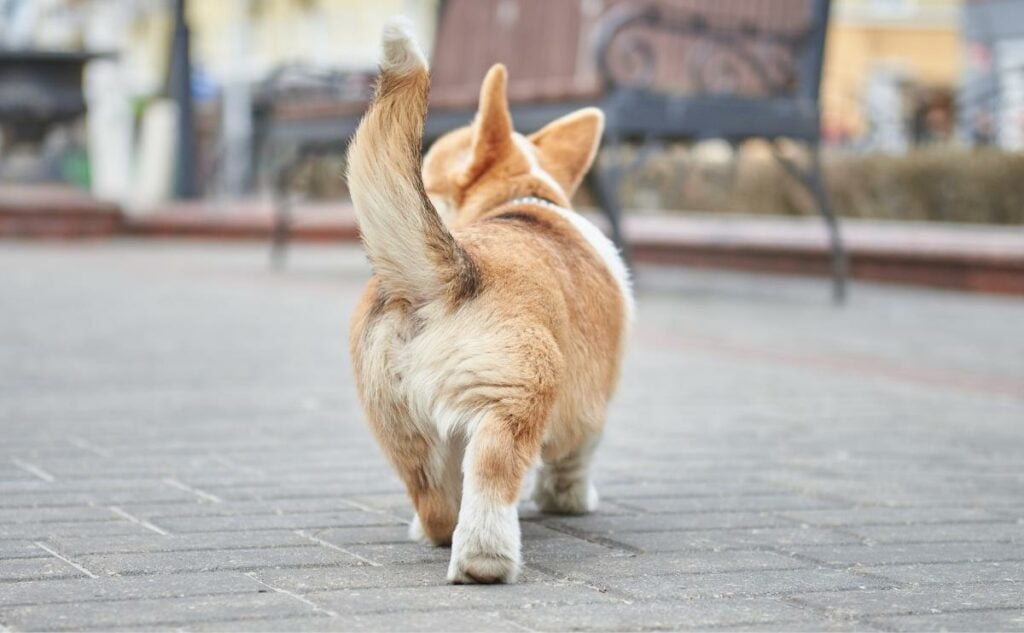
For years, we’ve been conditioned to believe that a wagging tail is dog code for “I love you” or an automatic sign of joy. But what if that’s not always true? What if your dog’s enthusiastic tail-thumping actually means something totally different, something you weren’t expecting? What if a wagging tail is actually a warning sign?
Why do dogs wag their tails? The answer isn’t as simple as you think. If you’ve been assuming every wag is pure happiness, you might want to rethink everything. Some wags are friendly, and some wags are nervous. And there are some wags that you probably don’t want to ignore. Keep reading because not all wags are created equal, and your dog might be trying to tell you something important.
Why Do Dogs Have Tails? 3 Main Reasons
A dog’s tail isn’t just for knocking over drinks. It’s a built-in Swiss Army knife for communication, balance, navigation, and survival. Whether wagging, tucked, or stiff as a board, tails can sometimes speak louder than barks and help dogs navigate the world.
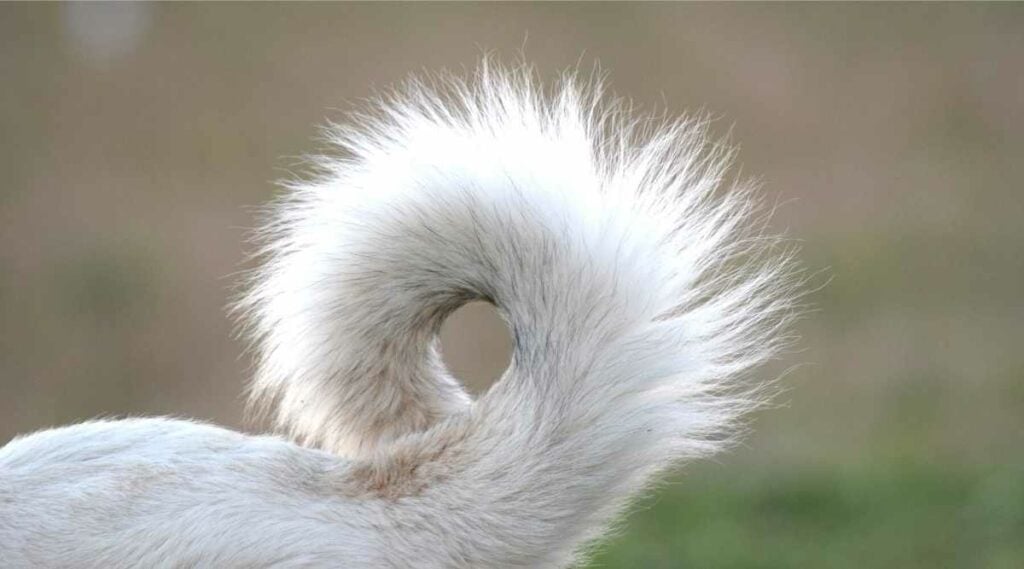
1. Communication: The Ultimate Mood Decoder
Think of a dog’s tail as a built-in emoji system. They use it to communicate their feelings to humans and other dogs. A wagging tail might mean excitement, nervousness, or even a warning to back off. Dogs would have to rely on dramatic sighs and judgmental stares without tails, just like humans.
2. Balance: The Original Stability Hack
A tail acts as a counterweight to balance. They keep dogs from wiping out like a cartoon character when they sprint, turn, or leap. Fast runners, climbers, and swimmers use their tails to stay steady, while short-tailed dogs make up for it with extra chaos. Dogs breeds that love to swim, like Newfoundlands, also use it to steer their body through the water.
Did You Know?
Communication is only one way dogs use their tails. For several breeds, tails are important for balance and movement. That’s one of the many reasons the American Veterinary Medical Association (AVMA) and other organizations oppose dog tail docking for purely cosmetic or breed-standard purposes.
3. Protection: Built-In Survival Gear
Cold-weather dogs like Huskies use their tails to cover their noses for warmth, while confident dogs raise theirs to look bigger and more intimidating. Some tails even help with defense because nothing says “stay away” like a stiff, dominant tail.
How Tail Wagging Evolved: Wolves vs Domesticated Dogs
Let’s start from the beginning. Have you ever wondered if wolves wag their tails like dogs? Turns out they do, but not in the way you might think. Tail wagging isn’t just some cute, happy habit dogs developed. It has deep evolutionary roots.
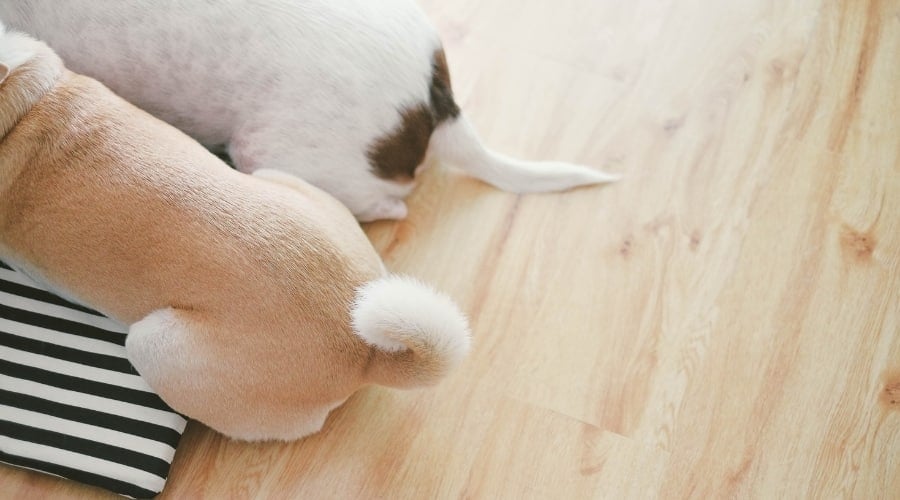
Before dogs became our best friends, they were wild animals (just like their wolf ancestors). Over time, domestication changed their behaviors, including how they use their tails to communicate. So, what’s the difference between how wolves and dogs wag their tails, and how did this behavior evolve? Let’s break it down.
Do Wolves Wag Their Tails? Yes, But Only In Specific Situations
When you picture a wolf, you probably imagine a fierce, independent predator, not a tail-wagging, happy-go-lucky pup. But wolves do wag their tails, just not in the same way dogs do. Unlike domesticated dogs, who use tail wagging as a constant communication tool, wolves only wag in very specific social situations. Their tail movements are much more reserved and serve a different purpose in the wild.
So, when do wolves wag their tails?
- Submissive wolves wag their tails toward dominant pack members to show respect and avoid conflict.
- Pups wag their tails more than adults, which is usually a sign of submission or excitement when greeting older pack members.
- During cooperative interactions, like hunting or bonding moments, wolves may wag their tails slightly.
And when don’t wolves wag their tails?
- Wolves don’t wag their tails at humans because they haven’t evolved to seek human approval like dogs.
- They rarely wag during play like dogs do because their pack dynamics are based on hierarchy and survival.
Ultimately, wolves use tail wagging as a tool for survival rather than an emotional display. This fundamental difference in tail communication is a key reason why domesticated dogs, who evolved to interact with humans, wag far more frequently and in a much wider variety of situations.
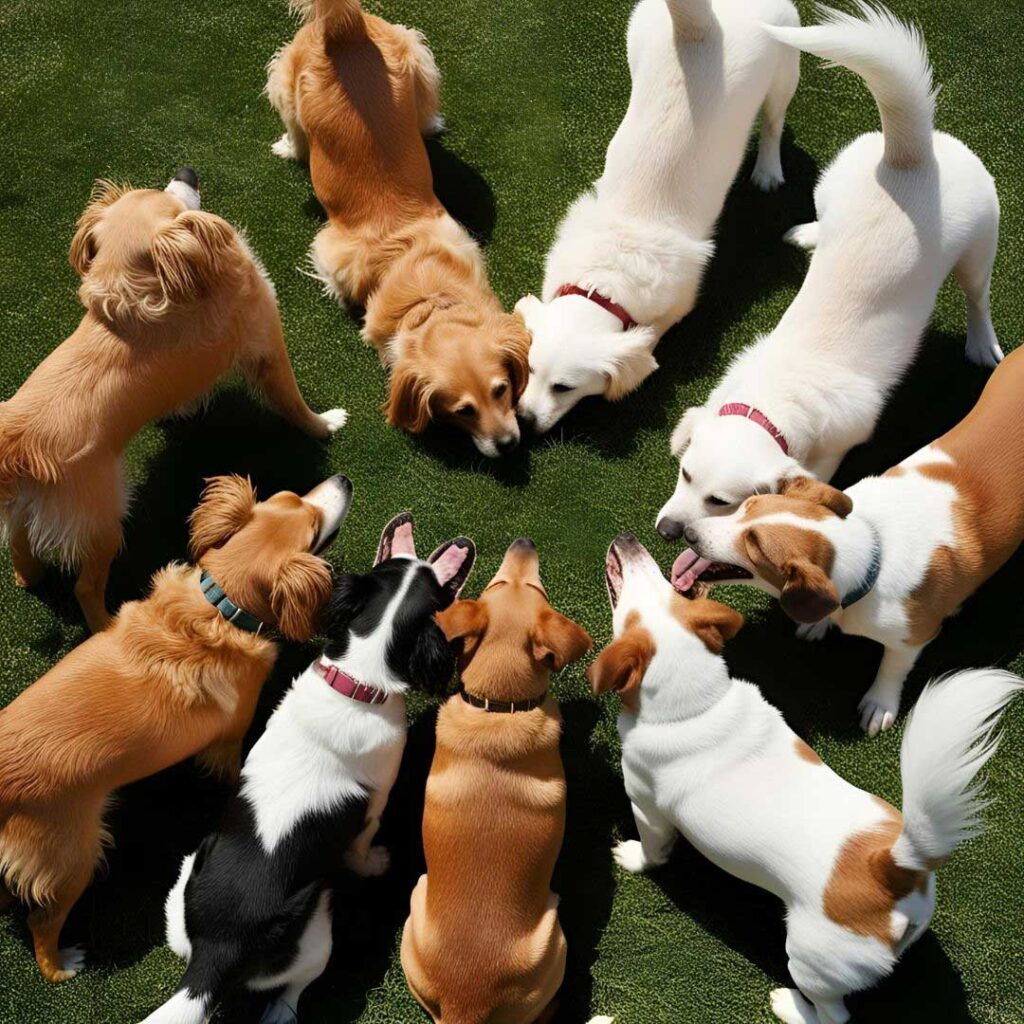
Do Dogs Wag Their Tail On Purpose?
Yes and no. Dogs have control of their tails and often consciously use them to communicate their moods. A dog’s tail wagging is controlled by their brain’s emotional center. So, it’s not random; it’s hardwired behavior. If humans had tails, we’d likely do the same thing. Instead, we smile, frown, or display other emotions on our faces and through body language. Their tail is part of their body language.
How Do Dogs Wag Their Tail?
Canines control their tail muscles in the same way as other body parts, like their ears and legs. A dog’s brain sends a signal to the tail muscle to manipulate its movement in varying ways. Our furry friends not only can wag their tails at will, but they also can consciously control the position and speed.
So what does a wagging tail mean? Our canine sidekicks wag their tails to express a variety of feelings.
The Science Of Tail Wagging: What’s Really Going On?
You see a wagging tail, and your brain automatically translates it to “Yay! My dog loves me!” But what if your dog’s tail is actually sending a totally different message? Science says tail wagging is way more complicated than just a sign of happiness. It’s a full-blown communication system that dogs use to express everything from excitement to fear to “Back off, human.” Researchers also believe that canines can detect the intent behind tail wags amongst other dogs.
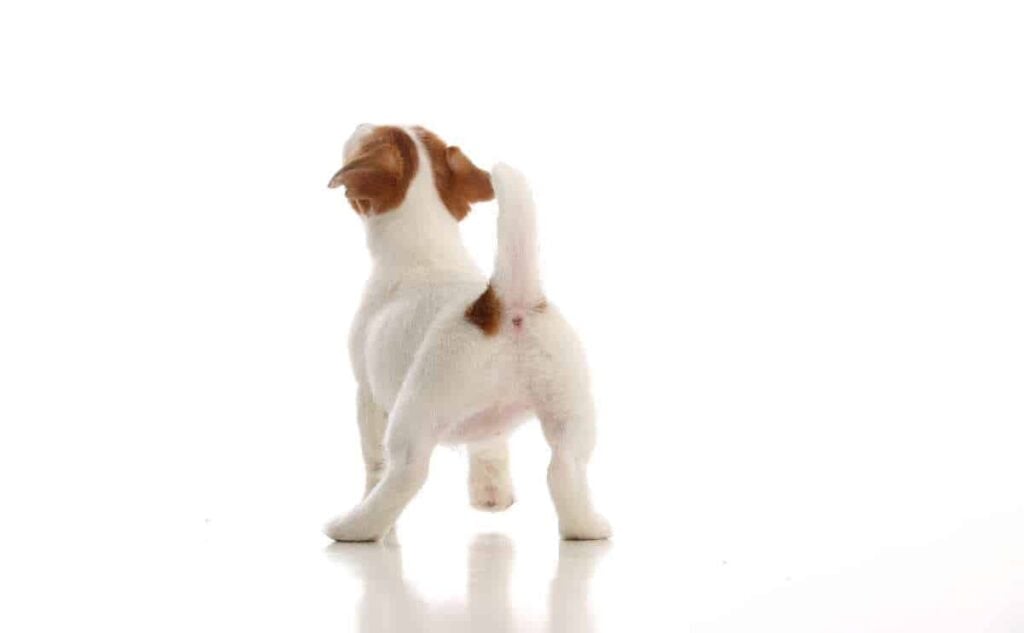
Despite research on why dogs wag their tails, we don’t know a huge deal about it, and there’s a lot more to be done. A fascinating 2018 review of previous scientific findings on dog behavior illustrated the two primary observations about how dogs use their tails to communicate.
1. Tail Position
Dogs don’t just wag their tails; they position them like signals. The height of your dog’s tail can reveal whether they’re confident, anxious, playful, or feeling threatened. If you’ve been ignoring tail height and only focusing on the wag, you’re missing half the message.
Let’s break down the three key tail positions and what they really mean.
- Held High. Conveys confidence, alertness to something or someone, or a “willingness to positively approach another individual, for example, greeting and playing.”
- Held Low. A tail held low or tucked between the legs is a sign of fear, anxiety, or appeasement. Researchers believe dogs use this tail position because it decreases their body size.
- Held Stiff. Expresses that the dog is feeling threatened or anxious.
2. Wagging Speed
Researchers also believe that the speed of a tail wag conveys the emotional level of how a dog is feeling. It’s not just which way a tail wags. It’s also how fast, how high, and how loose or stiff it is.
- Fast, Loose Wag. This typically means a relaxed, happy, social dog.
- Slow, Stiff Wag. Often, this is their caution mode, and your dog is evaluating the situation.
- Low, Slow Wag. This type of wag usually means they are nervous or unsure about what’s happening.
- High, Rapid Wag. Typically, this means dominance or even aggression.
Dogs don’t wag their tails just for fun. Unlike humans, who rely on words (or awkward hand gestures when words fail), dogs use body language, and their tail is one of their most powerful communication tools. So, if you’ve been assuming every tail wag means a happy pup, you might want to pay closer attention. Not all wags are created equal.
Let’s Break It Down – What Different Tail Wags Actually Mean
If you’ve ever thought, “A wagging tail means a happy dog,” get ready to rethink everything. Tail wagging is a full-blown language. Different types of wags can mean excitement, nervousness, submission, or even aggression. The key to understanding your dog isn’t just looking for a wag. It’s recognizing how they wag.
Here’s a breakdown of what different tail wags actually mean and how to decode your dog’s emotions like a pro.
Fast Wag vs Slow Wag: Excitement Or Caution?
Fast Wag: A dog wagging their tail rapidly, often with their whole body moving, is usually happy, excited, and social. You’ll see this when you come home from work, grab the leash for a walk, or open the treat jar. This kind of wag is often paired with a loose, relaxed body posture, indicating your dog is eager for interaction.
Slow Wag: A slow-moving wag is a mixed signal, and it doesn’t necessarily mean happiness. Instead, it’s often a sign that your dog is cautious or unsure. If a dog is meeting a new person or animal and wagging very slowly, they might be evaluating the situation rather than expressing joy. A slow wag with a stiff posture? That’s a warning sign that your dog might not be as friendly as you think.
Think all tail wags are friendly? A slow wag could mean your dog is weighing their options. Stay tuned to learn what stiff wags mean!
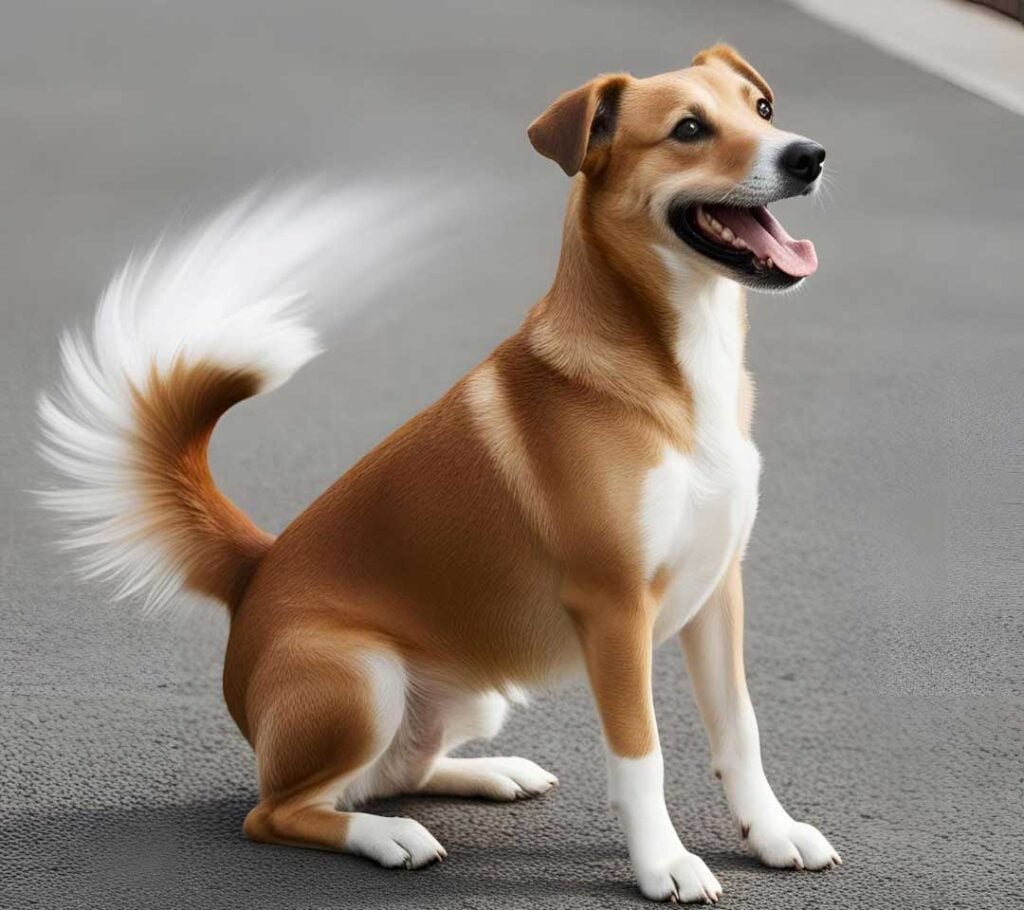
High Wag vs Low Wag: Confidence Or Submission?
High Wag: When a dog holds their tail high and wags it confidently, they’re feeling dominant, alert, or even playful. This type of wag is common in confident dogs, especially when they’re greeting someone or another dog. However, if the tail is high and stiff, it could signal dominance or even aggression.
Low Wag: A tail held lower than usual while wagging can indicate uncertainty, nervousness, or submission. If a dog is unsure about a new environment, person, or situation, they might keep their tail lower and wag cautiously.
Fun Fact
Some breeds, like Greyhounds and Whippets, naturally carry their tails lower, so their low wag doesn’t necessarily mean fear. Remember, context is key!
A high wag could mean playfulness or a power move. How do you tell the difference? Keep reading to find out!
Loose Wag vs. Stiff Wag: Relaxed Or Ready To Fight?
Loose Wag: A relaxed, floppy wag that involves the whole body is the classic “happy dog” signal. This is the tail wag you want to see: a joyful, wiggly, stress-free pup.
Stiff Wag: A wag that is rigid, slow, or tense is a huge warning sign. This type of wag means your dog is on high alert, feeling threatened, or possibly about to react aggressively. If the tail is stiff and high, the dog may be preparing to assert dominance or defend itself. If it’s stiff and low, the dog may be scared but ready to lash out if necessary.
Warning
Many people assume that any wagging tail means friendliness, but a stiff wag can be a sign that a bite is coming. Never reach for a dog with a stiff, tense tail.
Loose tails mean happy dogs, and stiff tails mean warning signs. But what about tails that wag in different directions? Science has the answer!
Left vs Right Tail Wagging: Why It Matters
In a 2013 study published in Current Biology, scientists also discovered that the direction of a dog’s tail wag matters. They found that dogs wagging their tails more to the right tend to be experiencing positive emotions, like excitement or relaxation. Dogs wagging their tails to the left may feel anxious, uncertain, or even fearful.
What this means for you:
- Right-side Wagging: Linked to positive emotions (happy, relaxed, excited).
- Left-side Wagging: Associated with stress, fear, or uncertainty.
Ever seen a dog wagging their tail but acting nervous? Their brain might be sending mixed signals, so let’s talk about when wagging means stress!
Tucked Tail With Wagging: A Confused Or Conflicted Dog
Ever seen a dog’s tail tucked between their legs but still wagging slightly? This is one of the most misunderstood dog signals. A tucked tail usually means fear, stress, or submission, but when a dog also wags their tail, it means they are conflicted. They might want to interact but are nervous or unsure about whether it’s safe.
When To Be Careful
- If a dog’s tail is tucked tightly but they’re still wagging, they are likely scared but trying to be non-threatening.
- If a dog is cornered or in an unfamiliar situation, they might tuck their tail and wag nervously before reacting aggressively.
- A rescued or traumatized dog may exhibit this behavior when meeting new people. It’s a sign that they are still figuring out if they can trust you.
Pro Tip
If a dog has a tucked tail but is wagging, don’t approach too quickly. Let them come to you on their terms.
What Is A “Flagging” Tail?
Flagging is when a dog holds their tail in a high position and waves it stiffly back and forth. This type of wag means that a dog is perceiving a threat. The flagging movement is one way dogs try to make themselves look bigger and more threatening. Check out this brief video to see what a flagging tail looks like so you can recognize this important cue.
Remember This When Interpreting Your Dog’s Tail Wags
Interpreting a dog’s tail-wagging meaning mainly depends on a pup’s tail position and wagging speed. However, you also have to consider each dog’s tail position when a pup is relaxed, for example, the starting point before a wag begins. While many canines’ natural tail position is hanging down near their heels, some breeds, like Beagles, naturally hold their tails upright. Other breeds have extremely short, or corkscrew, tails, which can make them more challenging to interpret.
Keep in mind that it’s also equally important to pay attention to other body language cues your pup is exhibiting at the same time. This is what I explore next.
How To Read Your Dog’s Full Body Language: More Than Just A Wagging Tail
If you’re relying only on your dog’s tail to understand how they’re feeling, you’re only getting part of the picture. A wagging tail might make you think a dog is happy. But if the rest of their body is stiff or tense, they could be nervous, uncomfortable, or even ready to react aggressively.

To truly understand your dog’s emotions, you need to look at their entire body language. Think of it as a puzzle. Each piece (tail, ears, eyes, mouth, and posture) gives you a clearer picture of what your dog is actually feeling.
1. Ears: The First Clue To A Dog’s Mood
Your dog’s ears can tell you a lot about how they’re feeling. Perked-up ears that point forward typically signal curiosity, excitement, or alertness. This is common when a dog hears a noise, spots something interesting, or is eagerly waiting for food. If the tail is wagging in a loose, relaxed way along with perked ears, it’s a good sign your dog is feeling happy and engaged.
On the other hand, ears that are pinned back against the head can indicate fear, stress, or submission. Dogs in unfamiliar situations or those who feel threatened may flatten their ears to appear smaller and less confrontational. If pinned-back ears are paired with a slow, stiff wag and a rigid body, it can be a clear warning sign that your dog is anxious or uncomfortable.
2. Eyes: The Window To A Dog’s Soul (Or Stress Level!)
A dog’s eyes can reveal whether they feel calm and content or is stressed and defensive. Soft, relaxed eyes, sometimes with gentle blinking, show that a dog is comfortable and happy. This is the classic “puppy dog eyes” expression you see when your dog is lounging or looking up at you for treats. However, a hard stare, wide eyes, or an intense, unblinking gaze is a major red flag. If a dog is staring intently without blinking, they might be feeling dominant, uneasy, or even preparing to react aggressively.
Another warning sign is “whale eye”, when you can see the whites of a dog’s eyes more than usual. This often means they are uncomfortable, nervous, or trying to avoid confrontation while still feeling threatened. If you see a hard stare combined with a stiff body and slow wag, it’s best to give the dog space.
3. Mouth: More Than Just Smiling Or Growling
Many people assume that a dog with their mouth open is always happy, but that’s not always the case. A relaxed mouth that is slightly open, with a loose jaw and tongue hanging out, typically means a content and comfortable dog. Panting after playtime is usual, but excessive panting in an otherwise calm setting can signify stress.
A tight-lipped, closed mouth with tension around the jaw, however, is often a sign of discomfort, anxiety, or defensiveness. Dogs who feel uneasy may hold their mouths tightly shut, almost as if they are bracing for something they don’t like. If a dog licks their lips or yawns excessively (without being tired), they are displaying calming signals, often trying to de-escalate a stressful situation. These subtle cues are easy to miss but can tell you a lot about your dog’s emotional state.
4. Posture: Is Your Dog Loose & Relaxed Or Stiff & Anxious?
A dog’s overall posture is one of the clearest indicators of how they’re feeling. A loose, wiggly body with relaxed movements means your dog is comfortable and social. Dogs that bounce, play bow, or move in a bouncy way are showing friendliness and excitement. However, a stiff, rigid body posture is a warning sign.
If a dog freezes in place, tightens their muscles, or stands still with a slow wag, they are likely feeling threatened or unsure about a situation. A stiff body combined with a high, slow-moving wag could indicate dominance or assertiveness, while a stiff body with a low tail may signal fear-based defensiveness. If a dog’s body remains rigid for more than a few seconds, do not assume they are just waiting; they may be processing whether to react.
If you’re having trouble deciphering your dog’s body language or behavioral cues, it is worth reaching out to a canine behaviorist who can assist you.
Frequently Asked Questions
Here are some questions owners often ask about tail wagging. If you don’t see your question, please ask us in the comments below, and we’ll find the answer for you.
Can Dogs Be Happy Without Wagging Their Tails?
Yes. Like most canine behaviors, some dogs use their tails much more than others to communicate. And some breeds, like Golden and Labrador Retrievers, are naturally more robust waggers than others. For example, dogs with corkscrew tails, such as French Bulldogs, Pugs, and Boston Terriers, simply have a harder time wagging due to their tail conformation. Just because your dog isn’t wagging their tail doesn’t mean they’re unhappy. Your pup may use other body language to show happiness.
Why Has My Dog Stopped Wagging Their Tail?
If you’ve noticed that your dog’s tail isn’t wagging the way it used to or seems limp, they could have limber tail. This condition most often occurs due to a tail muscle sprain or strain from overexertion while swimming and excessive exercise.
Some other issues that could cause a limp tail include trauma, impacted anal glands, and intervertebral disc disease (IVDD). If you’re concerned about your furry friend’s tail movement, contact your vet as soon as possible.
When Do Puppies Start Wagging Their Tails?
As adorable as it would be, newborn puppies don’t wag their tails. Most don’t begin until they’re around three to four weeks old. Most experts believe this delay occurs because tail wagging is a socially learned behavior from a puppy’s mother.
Learn More About Your Dog’s Behavior
Tail wagging might be one of their more socially acceptable forms of communication, but dogs rely on body language, scent, and gross personal choices to navigate the world. From sniffing crotches like they’re checking IDs to eating poop like it’s a Michelin-starred delicacy, canine behavior often leaves humans equal parts amused and horrified. Zooming around the house? That’s just their inner gremlin taking over. While we might cringe at their habits, most behaviors have an evolutionary or instinctual reason behind them.
Have you ever misread your dog’s tail wag before? Let us know in the comments!
Why Trust Canine Journal?
Sally has over 20 years of experience in human health sciences communications, including 10 years as an expert on pet health conditions and treatment. She’s part of a team of dedicated canine professionals and long-time dog owners at Canine Journal. We test and research the best pet products, not only for our own pups but for all of our readers.

